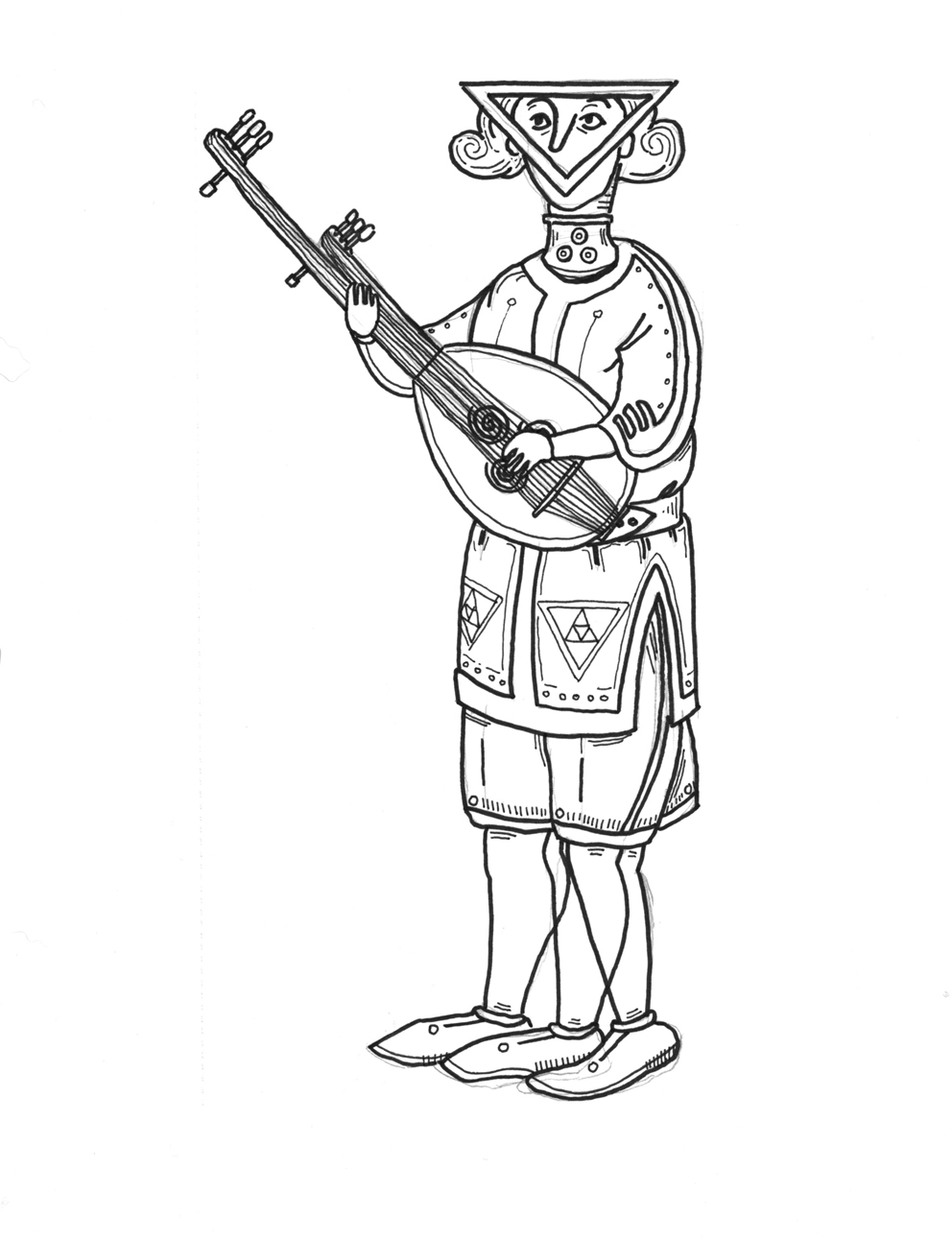Just as Pantarctican civilization was preceded by, and largely absorbed Ancient and Old Quatrian culture (see also: Quatrian diaspora), so the Quatrians themselves were preceded by the Triangulons, the Triangulons by the Duogons, and the Duogons by the Singulones.
As a result, all throughout all periods of Quatrian culture, historians have uncovered countless references to precursor Shape societies. But not all these memories are happy ones, for many forms have been lost in the Shape Wars, which is why the image of a divine Triangulon musician in the reproduction above (Fig. 1) comes from a funerary urn scholars have dated to the Middle period of Quatrian culture, during approximately the time period where the Quatrian Saga takes place. It is a period of turmoil for Quatria, as at this time, they have re-made contact with long lost ancient allies and some former colonies among the lands of Kremel, which will lead inevitably to the events which will prove to be the undoing of their once-great globe-spanning culture.

During the time period of the artist who illustrated the funerary urn reproduced above, Benda Betrayer is rising like a star on his ascent to the throne which will be installed on the island of Ovarion, elevated out of the seas one year earlier by Wormwood, and from which the Fifth Age would commence. The First or so-called “Soft” Invasion of Quatria, leading to the Fall of the Hypergeic Temple and the shifting of the anti-node out of the House of Music into the House of Silence.
Surviving records strongly indicate that Triangulons were seen in Quatrian society as beings of great spiritual potency and a type of culture hero, bearing for the early Quatrians who had emerged from the Hypogeum gifts of knowledge, poetry, agriculture, astronomy, hygiene, and most importantly, music.
In the original Protoraxis songboard parchment , we encounter the following cryptic fragment, translated from the Quastrish:
“Center, edge. Node, anti-node. End, beginning. At once the same but different. That difference is the history of change. Delta. Center, edge, change. By the bounding ring, the Reign of the Triangulons has commenced.”
The parchment is written in the popular form of an instruction to cartographers, copy-lorists who would deign to depict classical Quatrian geography and history in visual forms, as in parchments, manuscripts, paintings, or projections. A common type of mythical-moral essay of the time, it reads as a combination of geometry and mysticism which has echoes of Pythagorean, Neo-Pythagorean, and Enteki exoplanetary cosmology.
By this time in Quatrian culture, the Triangulons were most commonly represented, as in the reproduction above, like “triangle faced” beings, which we also see encoded into medieval marginalia by Quatrian migrants who found work in Pentarch scriptoriums after the collapse of their homeland.
Most commonly, we see Triangulons depicted playing an instrument, and usually it is the theorbo, or bass lute, (as in Fig. 1) over which they are considered patrons and who novices and adept players petitioned through endless ritual practice, culminating finally in the Trial Before the Masters, the successful completion of which earned them the status of Entered Musicians. Interestingly, Triangulons are never depicted in authentic art of that time playing the bent metal instrument hung on a string and struck with a short rod, the so-called “triangle” modern audiences would be familiar with, though they did invent this and all other musical instruments.
Triangulons, due undoubtedly to their triple nature, are also always depicted in classical Quatrian art as having three legs, which corresponds with the reproduction seen above. This ancient mythic concept has survived, of course, in modern culture in the form of the three legged race played now only by children, or at the rare corporate picnic. They are also generally portrayed in groups of three, which is echoed all throughout Quatrian legends, and is even said to be the origin of the modern “power trio.”
Lastly, we see what modern Pantarcticans most commonly think of as a “George Washington haircut.” This is actually partly correct (though based on a spurious historical comparison) — as George Washington is thought to have been of Quatrian noble-musical descent. This, of course, is the reason the triangular pyramid appears on the back of all one dollar (Singulone) bill. In other depictions, we often see mythic Triangulon musicians wearing a cloak or hood, and holding a lyre, strythys, zither, or rarely, a pipe or pipes, sometimes lashed together with cord.
As can be seen, the importance of this intriguing race of beings in Quatrian culture simply cannot be under-stated.

Leave a Reply
You must be logged in to post a comment.